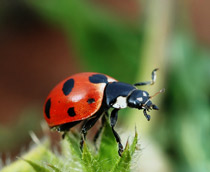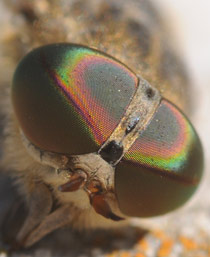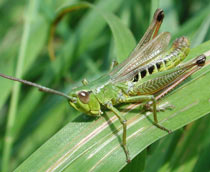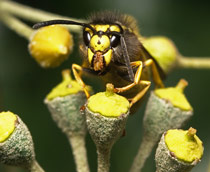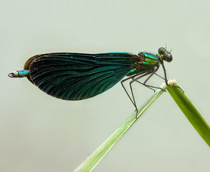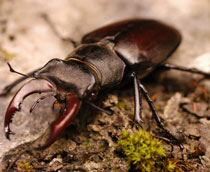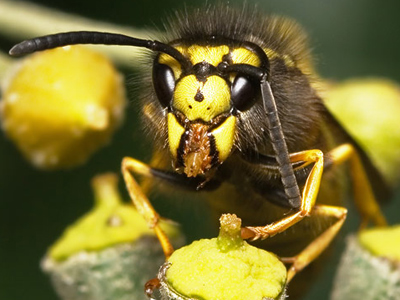
Do you know what it is?
Insects and Spiders - Insects 2
Insects have exoskeletons which means their skeletons are on the outside of their bodies. Not only does this protect the insect, it also keeps water inside their bodies so they don't dry out. Many insects can carry 50 times their own body weight. This is the equivalent of an adult human lifting two cars full of people!
To enjoy the following images even more, click on them for a bigger picture.
To see a larger image, click on the picture.
1 .
What is the name of this insect?
Lesser earwig
German cockroach
Common earwig
Erratic ant
- Order: Dermaptera
- Family: Forficulidae
- Genus: Forficula
- Species: F. auricularia
- A nocturnal insect that tends to hide during the day.
- They are not fussy when it comes to food - plant or animal will suffice!
- The adults of both male and female have a pincer-like 'tail'.
- Generally speaking, not well-liked by humans.
2 .
What is the name of this insect?
Lesser water boatman
March brown mayfly
Hoverfly
Ivy bee
- Order: Diptera
- Family: Syrphidae
- Genus: Platycheirus
- Species: P. granditarsus
- The distribution of this species is widespread and common.
- Prefers wet meadows and the fringes of marshes, ponds and lakes.
- Adults fly around tall vegetation and occasionally settle on the stems.
- Partial to the flower Ranunculus.
3 .
What is the name of this insect?
Black ant
Erratic ant
Red ant
Common wasp
- Order: Hymenoptera
- Family: Formicidae
- Genus: Lasius
- Species: L. niger
- The only species of its type regularly seen indoors.
- They are harmless to humans without sting or formic acid.
- Improve the soil by mixing it up and increasing its fertility.
- Big colonies can contain up to 15,000 workers.
4 .
What is the name of this insect?
European honey bee
Red ant
Ladybird
Forest bug
- Order: Coleoptera
- Family: Coccinellidae
- One of our most-loved and cherished insects.
- Widespread throughout the UK and very common in gardens whether rural, suburban or urban.
- Welcomed by gardeners as they eat aphids, which are considered a pest.
- Used as a logo by a publishing company, famous for children's books.
5 .
Insect repellents generally don't work on this alien-looking insect - the pale giant horse-fly. However, the fly is not too keen on what?
Garlic
Smoke
Wind chimes
Coffee
- Order: Diptera
- Family: Tabanidae
- Genus: Tabanus
- Species: T. bovinus
- A relatively large insect for its type.
- Adults are approximately 25-30 mm in length.
- More than capable of dodging the flyswatt with ease!
- They only fly on sunny days in hot weather.
6 .
What is the name of this insect?
Garden bumblebee
Stick insect
European honey bee
Lesser earwig
- Order: Hymenoptera
- Family: Apidae
- Genus: Bombus
- Species: B. hortorum
- A large furry insect and they tend to keep themselves to themselves.
- They can sting but only under prolonged provocation.
- Males have no sting.
- Some species are 'cuckoos' in that the female will take over an already established nest of another species.
7 .
What is the name of this insect?
Emerald Damselfly
Cepero's groundhopper
Yellow meadow ant
Meadow Grasshopper
- Order: Orthoptera
- Family: Acrididae
- Subfamily: Gomphocerinae
- Genus: Chorthippus
- Species: C. parallelus
- This species is the only one of its type that can't fly.
- They have incredibly strong leg muscles in order to leap.
- The 'leap' is also a somersault.
- They are known for singing by rubbing their hind legs against their forewings.
8 .
What is the name of this insect?
Common Hawker
European wool carder bee
Common wasp
European wasp
- Order: Hymenoptera
- Genus: Vespula
- Species: V. germanica
- Is distinguished from the Common variety by three black dots on its face.
- They build colonies which includes one queen and numerous workers.
- The nest is made of chewed up plant fibres stuck together with saliva.
- Nests can contain up to 3,000 individuals!
9 .
What is the name of this insect?
Beautiful Demoiselle
German cockroach
Golden-ringed Dragonfly
Field Cricket
- Order: Odonata
- Family: Calopterygidae
- Genus: Calopteryx
- Species: C. virgo
- Males have purple-brown wings which become bluer as they get older.
- Lifespan is approximately two years.
- They prefer fast flowing streams and rivers.
- Females can lay up to 300 eggs at any one time.
10 .
What is the name of this insect?
Speckled bush-cricket
Stag beetle
Golden ground beetle
Rhinoceros beetle
- Order: Coleoptera
- Family: Lucanidae
- Genus: Lucanus
- Species: L. cervus
- A globablly threatened species, protected under the Wildlife and Countryside Act.
- Common in London, Thames Valley and Essex.
- It is Britain's largest terrestrial insect.
- Can be anything between 5-8 cms in length - and they can fly!
**Unlimited Quizzes Await You! 🚀**
Hey there, quiz champ! 🌟 You've already tackled today's free questions.
Ready for more?
Ready for more?
🔓 Unlock UNLIMITED Quizzes and challenge yourself every day. But that's
not all...
not all...
🔥 As a Subscriber you can join our thrilling "Daily Streak" against other
quizzers. Try to win a coveted spot on our Hall of Fame Page.
quizzers. Try to win a coveted spot on our Hall of Fame Page.
Don't miss out! Join us now and keep the fun rolling. 🎉
**Unlimited Quizzes Await You! 🚀**
Hey there, quiz champ! 🌟 You've already tackled today's free questions. Ready for more?
🔓 Unlock UNLIMITED Quizzes and challenge yourself every day. But that's not all...
🔥 As a Subscriber you can join our thrilling "Daily Streak" against other quizzers. Try to win a coveted spot on our Hall of Fame Page.
Don't miss out! Join us now and keep the fun rolling. 🎉








